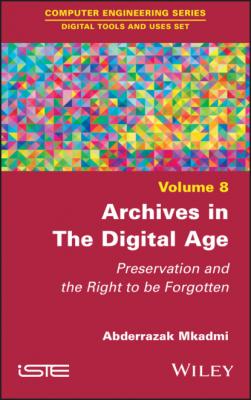Archives in the Digital Age. Abderrazak Mkadmi
Чтение книги онлайн.
Читать онлайн книгу Archives in the Digital Age - Abderrazak Mkadmi страница 9
 Technical form
Technical form
1.2.2. ERM: implementation steps
ERM is traditionally presented in four main stages, which are the acquisition, management, storage and distribution of documents. These stages can be complex, with other secondary or complementary stages depending on the size and type of project.
1.2.2.1. Acquisition of documents
The primary function of ERM is document acquisition. It results from a human or automatic process of dematerializing documents through “digitization“ (by means of scanners), production and/or integration. This process aims to create, save, classify and index the digital document.
The creation of the documents comes from different sources. The digitization of existing paper documents through scanners is the most widespread and fastest process. The scanner, also known as “digitizer”, is a data-processing device that enables the transformation of a document or a real object into a digital image. The choice of the scanners and their characteristics depends on the formats and the states of the documents to be digitized, as well as the needs in a given digitization project. Several models of scanner exist. These include:
– Flatbed scanner: this is the best-known and most widely used type of scanner for scanning unbound printed documents and handwritten pages (see Figure 1.3). This type of scanner consists of placing the document to be scanned on a glass plate and a light source mounted on a movable arm then scans the entire document to transform it into a digital image.Figure 1.3. Flatbed scanner (Epson). For a color version of this figure, see www.iste.co.uk/mkadmi/archives.zip
– Vertical scanner: this is a somewhat special version of the flatbed scanner (see Figure 1.4). The difference between the two is that, in this vertical version, the light and the sensors are placed at the top in a support bar under which the bound document can be placed open and facing upward. This type of scanner is very convenient for objects with some relief and for fragile objects, such as bound books.Figure 1.4. Vertical scanner (Amazon). For a color version of this figure, see www.iste.co.uk/mkadmi/archives.zip
– Scanner with feeder: uses the same technology as flatbed scanners, but with a feeder instead of a glass pane (see Figure 1.5). This type of scanner is well suited for scanning separate pages of the same size and is strong enough to withstand the handling of the feeders.Figure 1.5. Scanner with charger (Canon). For a color version of this figure, see www.iste.co.uk/mkadmi/archives.zip
– Drum scanner: this allows the best scanning among all types of scanners, with the highest resolution (see Figure 1.6). They are suitable for fragile documents and a certain skill is required in handling them. This type of scanner generally costs more than other types and is not suitable for all types of documents; they must be able to wrap around the cylinder and must be no thicker than 1 mm. Figure 1.6. Drum scanners (Fujifilm). For a color version of this figure, see www.iste.co.uk/mkadmi/archives.zip
– Book scanner: this is a device used to scan bound documents, such as registers or books (see Figure 1.7). There are many different models of book scanners with varying capacities.Figure 1.7. Book scanner (Wikimedia France). For a color version of this figure, see www.iste.co.uk/mkadmi/archives.zip
– Scanner with digital camera: for three-dimensional objects that are difficult to digitize flat, as well as for fragile documents.
– Scanner for microfiche and microfilm: this is used to digitize microfilm and microfiche.
All scanners work in almost the same way and in accordance with three principles: lighting, reflection and capture:
– the scanner uses a lamp to illuminate the page to be scanned;
– the mirror system leads the rays reflected on the page to a sensor bar called a CCD (Coupled Charged Devices) bar;
– the received light is transformed by the sensors into an electrical signal and is then processed by the electronic part of the scanner.
The choice of scanners is made according to several characteristics, of which the main ones are the resolution (measured in dpi [dots per inch]), speed (pages per minute), – the type of acquisition (black and white, grayscale, color)– and the format of the documents (A4, A3, A1, A0, etc.).
The creation of documents also comes from:
– digital document exchange: this is generally done through an EDI (Electronic Data Interchange) device by agreeing on a standardized data format (EDIFAC for Europe and ANSI X.12 for the United States);
– digital document production: in addition to the operations related to the management of existing documents, the DMS is also involved, in an equal way, in various operations of document production. Indeed, workflow tools allow the different agents to work on administrative procedures dealing with documents, scheduling, routing and job tracking. Groupware also offers communication, cooperation and document